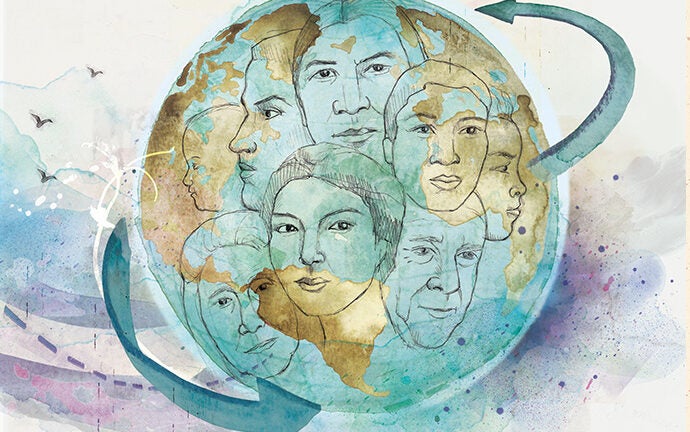
Big Data, Big Impact
When Daniel Benjamin was just beginning his Ph.D. program in economics in 2001, he attended a conference with his graduate school advisers. They took in a presentation on neuroeconomics, a nascent field dealing with how the human brain goes about making decisions.
Afterward, as they took a stroll outside, they couldn’t stop talking about what they had learned, how novel and intriguing it was. What would be next, they wondered. What would come after neuroeconomics?
“The human genome project had just been completed, and we decided that even more fundamental than the brain would be genes, and that someday this was going to matter a lot for social science,” said Benjamin, associate professor (research) of economics at USC Dornsife’s Center for Economic and Social Research (CESR). Indeed, his excitement that day was the foundation of a visionary academic path.
Fast forward to today. Genoeconomics is now an emerging area of social science that incorporates genetic data into the work that economists do. It is based on the idea that a person’s particular combination of genes is related to economic behavior and life outcomes such as educational attainment, fertility, obesity and subjective well-being.
“There’s this rich new source of data that has only become available recently,” said Benjamin, also co-director of the Social Science Genetic Association Consortium, which facilitates cooperation among medical researchers, geneticists and social scientists.
Collecting genetic data and creating the large data sets used by economists and other social scientists have become increasingly affordable, and new analytical methods are getting more and more powerful as these data sets continue to grow. The big challenge, he said, is figuring out how scientists can leverage this new data to address a host of important policy questions.
“We’re ultimately interested in understanding how genes and environments interact to produce the kinds of outcomes people have in their lives, and then what kinds of policies can help people do better. That is really what economics is about — and we’re trying to use genetics to do even better economics.”
Only a handful of economists are working with genetics, but this brand of research is perfectly at home at CESR. The center, founded three years ago, was conceived as a place where visionary social science could thrive and where research could be done differently than in the past.
“Being in a place where that’s the shared vision is pretty rare,” said econometrician Arie Kapteyn, professor (research) of economics and CESR director. “There’s no restriction on which way you want to go or what you want to do. It doesn’t mean that there are no restrictions on resources, but it’s the opportunity to think about your vision of what’s really exciting in social science research. Then being able to actually implement it is absolutely fantastic.”
The mission of CESR is discovering how people around the world live, think, interact, age and make important decisions. The center’s researchers are dedicated to innovation and combining their analysis to deepen the understanding of human behavior in a variety of economic and social contexts.
“What we try to do is mold a disciplinary science in a very broad sense,” Kapteyn said. “Because today’s problems in society, they’re really all multidisciplinary.”
Case in point: Benjamin’s work combining genetics and economics.
The flagship research effort for Benjamin’s CESR research group deals with genes and education. In a 2016 study, the team identified variants in 74 genes that are associated with educational attainment. In other words, people who carry more of these variants, on average, complete more years of formal schooling.
Benjamin hopes to use this data in a holistic way to create a predictive tool. “Rather than just identifying specific genes,” he said, “we’re also creating methods for combining the information in a person’s entire genome into a single variable that can be used to partially predict how much education a person’s going to get.”
The young field of genoeconomics is still somewhat controversial, and Benjamin is careful to point out that individual genes don’t determine behavior or outcome.
“The effect of any individual gene on behavior is extremely small,” Benjamin explained, “but the effects of all the genes combined on almost any behavior we’re interested in is much more substantial. It’s the combined information of many genes that has predictive power, and that can be most useful for social scientists.”
While the cohort of researchers actively using the available genome-wide data in this way is still somewhat limited, Benjamin says it is growing quickly.
“I think across the social sciences, researchers are seeing the potential for the data, and people are starting to use it in their work and getting excited about it, but right now it’s still a small band of us trying to lay the foundations.
“We’re putting together huge data sets of hundreds of thousands of people — approaching a million people in our ongoing work on educational attainment — because you need those really big sample sizes to accurately detect the genetic influences.”
As CESR works to improve social welfare by informing and influencing decision making in the public and private sectors, big data such as Benjamin’s is a growing part of that process, according to Kapteyn.
“What big data reflects is the fact that nowadays there are so many other ways in which we can learn about behavior,” he said. “As a result, I think we’ll see many more breakthroughs and gain a much better understanding of what’s going on in the world and in social science than in the past.
“I think we’re really at the beginning of something pretty spectacular. What we are doing is really only scratching the surface — there’s so much more that can be done.”
Read more stories from USC Dornsife Magazine’s Spring/Summer 2017 issue